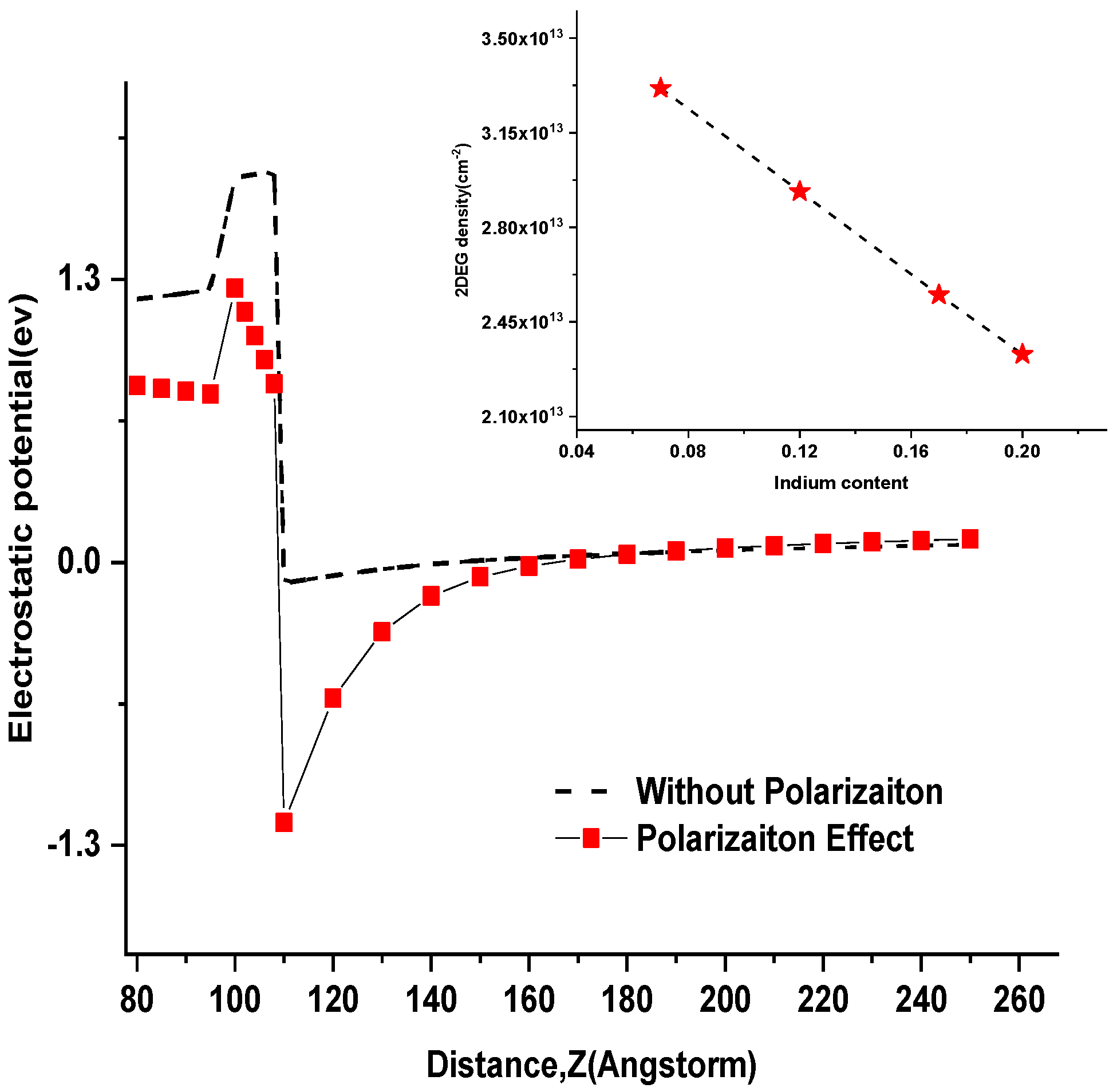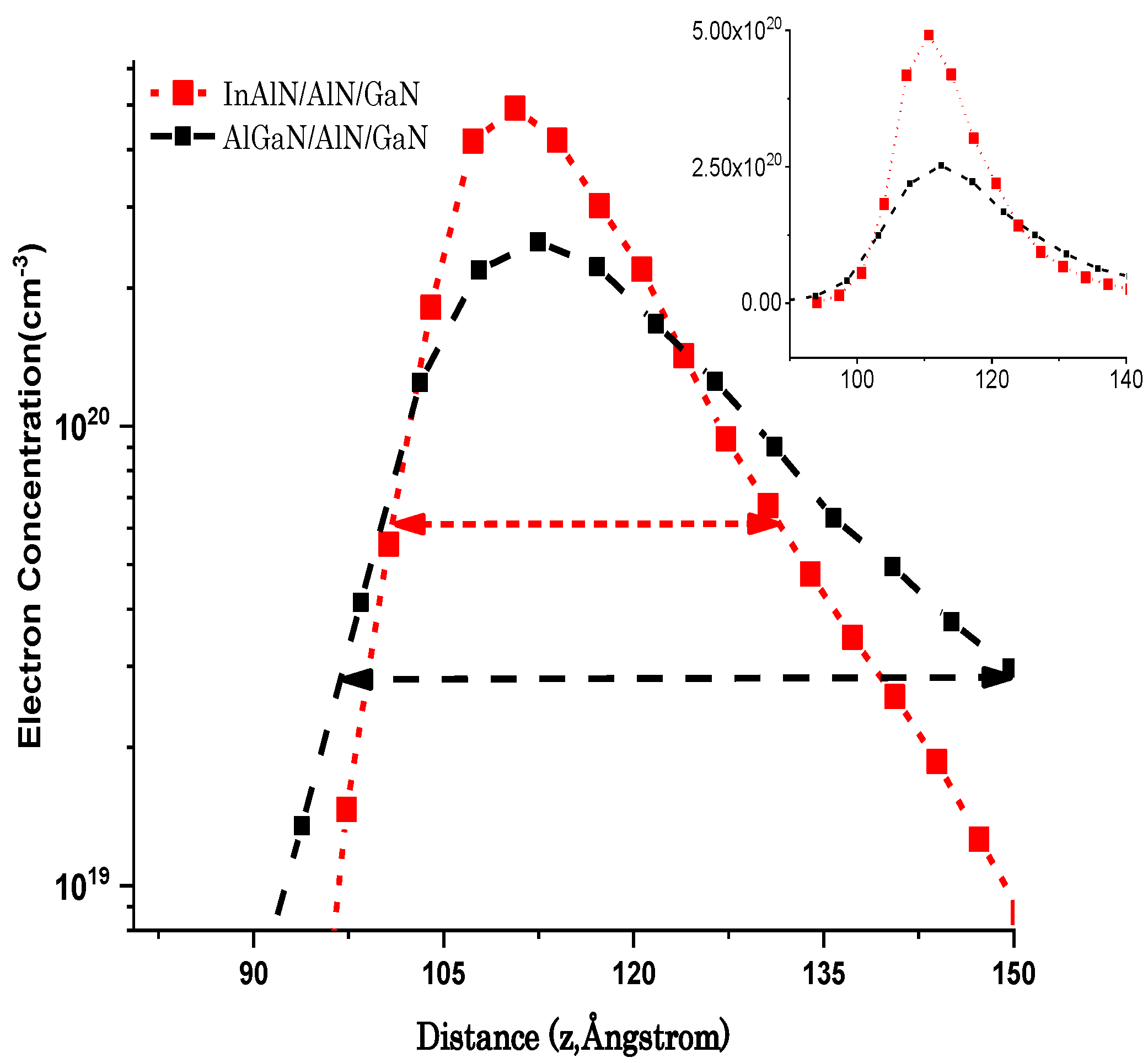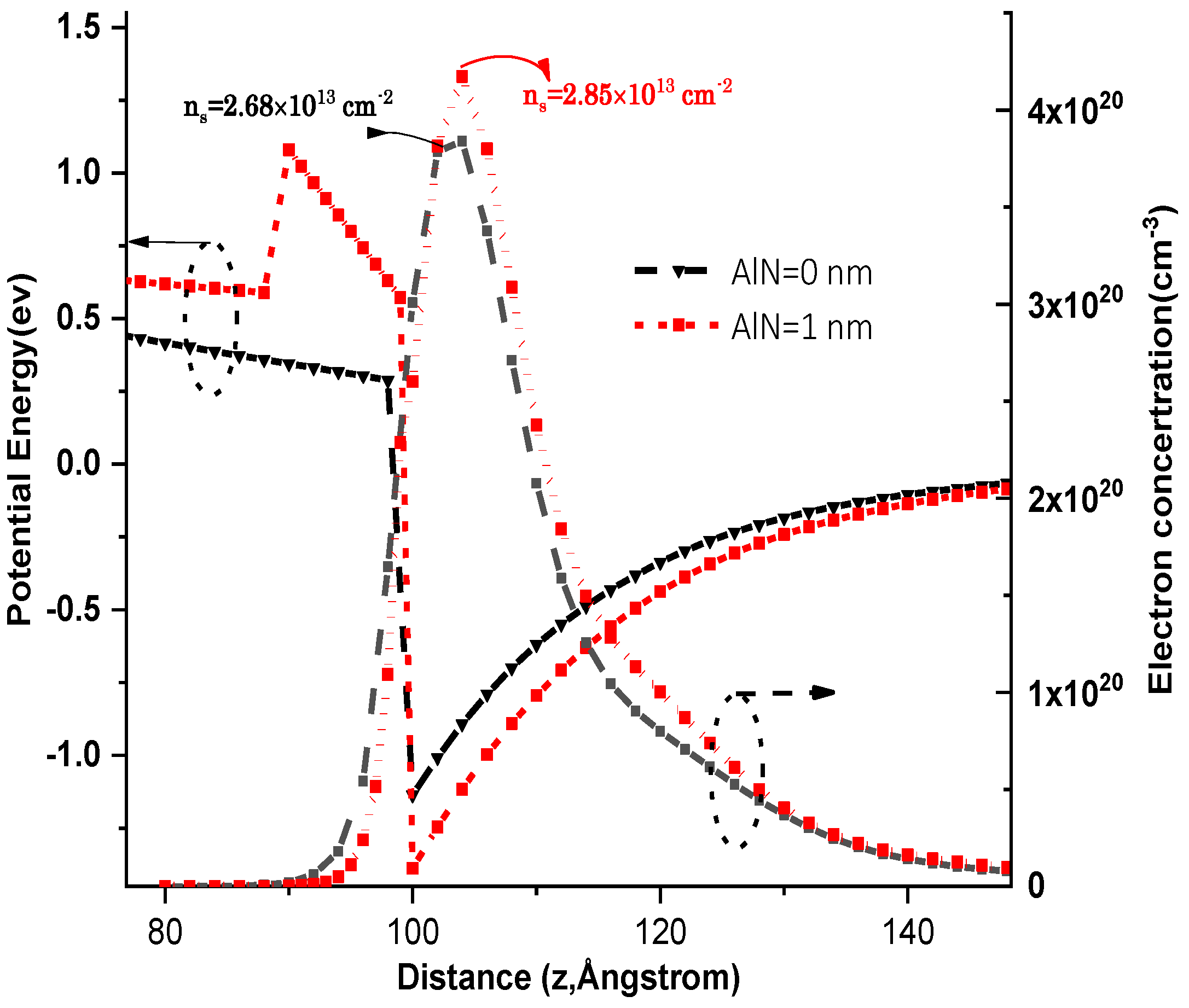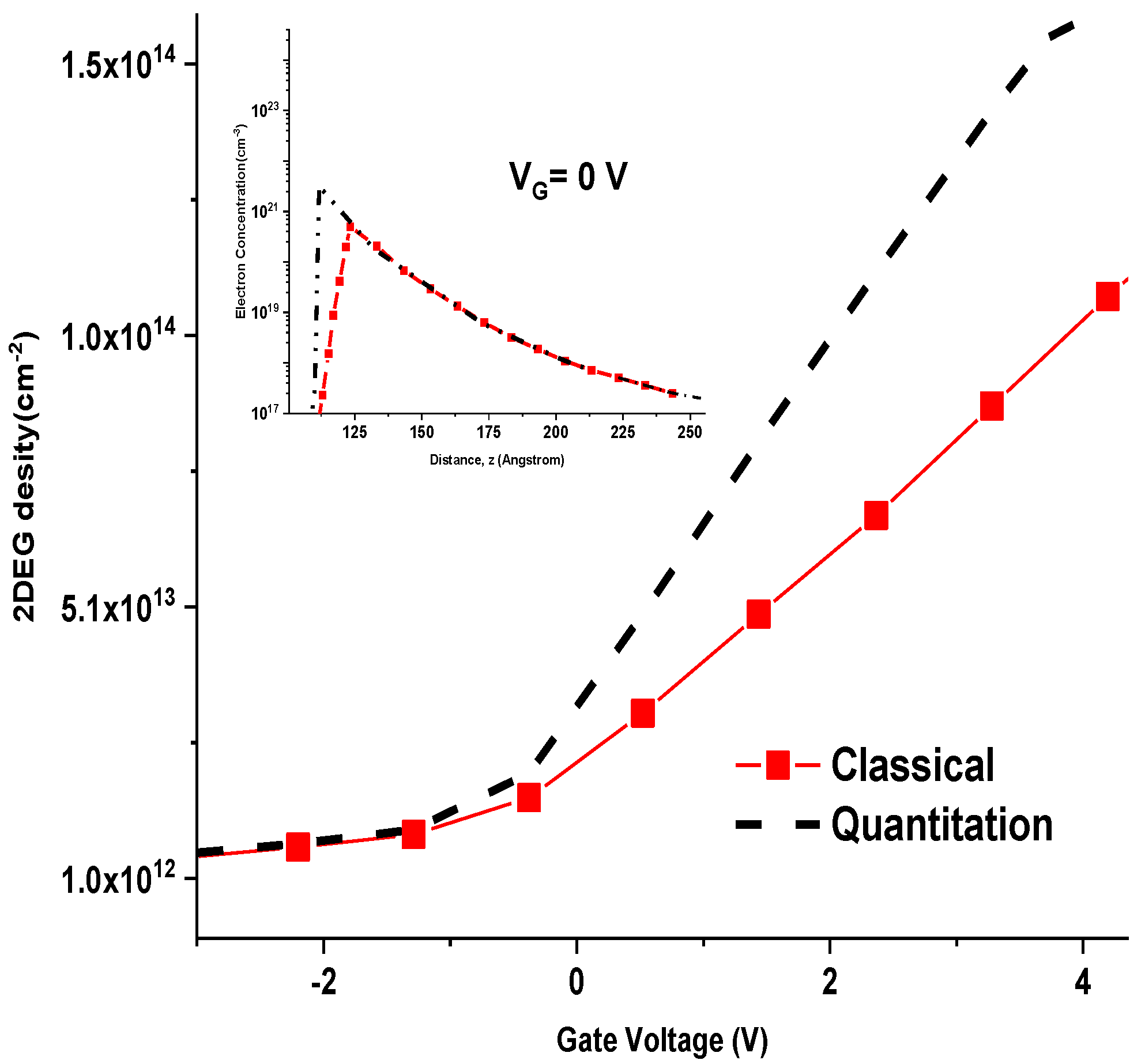Modeling of 2DEG characteristics of InxAl1−xN/AlN/GaN-Based HEMT Considering Polarization and Quantum Mechanical Effect
Abstract
1. Introduction
2. Modeling and Theory
2.1. Polarization Effect
2.2. Self-Consistent Calculations
3. Results and Discussion
4. Conclusions
Author Contributions
Funding
Conflicts of Interest
References
- Shen, L.; Heikman, S.; Moran, B.; Coffie, R. AlGaN/AlN/GaN high-power microwave HEMT. IEEE Electron. Device Lett. 2001, 22, 457–459. [Google Scholar] [CrossRef]
- Palacios, T.; Chakraborty, A.; Heikman, S.; Keller, S.; DenBaars, S.P.; Mishra, U.K. AlGaN/GaN high electron mobility transistors with InGaN back-barriers. IEEE Electron. Device Lett. 2006, 27, 13–15. [Google Scholar] [CrossRef]
- Menozzi, R.; Umana-Membreno, G.A.; Nener, B.D.; Parish, G.; Sozzi, G.; Faraone, L.; Mishra, U.K. Temperature-Dependent Characterization of AlGaN/GaN HEMTs: Thermal and Source/Drain Resistances. IEEE Trans. Device Mater. Reliab. 2008, 8, 255–264. [Google Scholar] [CrossRef]
- Hao, Y.; Yang, L.; Ma, X.; Ma, J.; Cao, M.; Pan, C.; Wang, C.; Zhang, J. High-Performance Microwave Gate-Recessed AlGaN/AlN/GaN MOS-HEMT With 73% Power-Added Efficiency. IEEE Electron. Device Lett. 2011, 32, 626–628. [Google Scholar] [CrossRef]
- Shinohara, K.; Regan, D.C.; Tang, Y.; Corrion, A.L.; Brown, D.F.; Wong, J.C.; Robinson, J.F.; Fung, H.H.; Schmitz, A.; Oh, T.C.; et al. Scaling of GaN HEMTs and Schottky Diodes for Submillimeter-Wave MMIC Applications. IEEE Trans. Electron. Devices 2013, 60, 2982–2996. [Google Scholar] [CrossRef]
- Yu, T.H.; Brennan, K.F. Theoretical study of the two-dimensional electron mobility in strained III-nitride heterostructures. J. Appl. Phys. 2001, 89, 3827–3834. [Google Scholar] [CrossRef]
- Yarar, Z.; Ozdemir, B.; Ozdemir, M. Electron mobility in a modulation doped AlGaN/GaN quantum well. Eur. Phys. J. B 2006, 49, 407–414. [Google Scholar] [CrossRef]
- Meng, F.; Zhang, J.; Zhou, H.; Ma, J.; Xue, J.; Dang, L.; Zhang, L.; Lu, M.; Ai, S.; Li, X.; et al. Transport characteristics of AlGaN/GaN/AlGaN double heterostructures with high electron mobility. J. Appl. Phys. 2012, 112. [Google Scholar] [CrossRef]
- Gonschorek, M.; Carlin, J.-F.; Feltin, E.; Py, M.A.; Grandjean, N. High electron mobility lattice-matched AlInN/GaN field-effect transistor heterostructures. Appl. Phys. Lett. 2006, 89, 062106. [Google Scholar] [CrossRef]
- Jeganathan, K.; Shimizu, M.; Okumura, H.; Yano, Y.; Akutsu, N. Lattice-matched InAlN/GaN two-dimensional electron gas with high mobility and sheet carrier density by plasma-assisted molecular beam epitaxy. J. Cryst. Growth 2007, 304, 342–345. [Google Scholar] [CrossRef]
- Pietzka, C.; Denisenko, A.; Alomari, M.; Medjdoub, F.; Carlin, J.-F.; Feltin, E.; Grandjean, N.; Kohn, E. Effect of Anodic Oxidation on the Characteristics of Lattice-Matched AlInN/GaN Heterostructures. J. Electron. Mater. 2008, 37, 616–623. [Google Scholar] [CrossRef]
- Dasgupta, S.; Lu, J.; Speck, J.S.; Mishra, U.K. Self-Aligned N-Polar GaN/InAlN MIS-HEMTs With Record Extrinsic Transconductance of 1105 mS/mm. IEEE Electron. Device Lett. 2012, 33, 794–796. [Google Scholar] [CrossRef]
- Smith, M.D.; O’Mahony, D.; Conroy, M.; Schmidt, M.; Parbrook, P.J. InAlN high electron mobility transistor Ti/Al/Ni/Au Ohmic contact optimisation assisted by in-situ high temperature transmission electron microscopy. Appl. Phys. Lett. 2015, 107, 4. [Google Scholar] [CrossRef]
- Tsou, C.W.; Lin, C.Y.; Lian, Y.W.; Hsu, S.S.H. 101-GHz InAlN/GaN HEMTs on Silicon with High Johnson’s Figure-of-Merit. IEEE Trans. Electron. Devices 2015, 62, 2675–2678. [Google Scholar] [CrossRef]
- Miao, Z.L.; Tang, N.; Xu, F.J.; Cen, L.B.; Han, K.; Song, J.; Huang, C.C.; Yu, T.J.; Yang, Z.J.; Wang, X.Q.; et al. Magnetotransport properties of lattice-matched In0.18Al0.82N/AlN/GaN heterostructures. J. Appl. Phys. 2011, 109, 016102. [Google Scholar] [CrossRef]
- Xue, J.; Zhang, J.; Hao, Y. Demonstration of InAlN/AlGaN high electron mobility transistors with an enhanced breakdown voltage by pulsed metal organic chemical vapor deposition. Appl. Phys. Lett. 2016, 108, 013508. [Google Scholar] [CrossRef]
- Zhou, H.; Lou, X.; Conrad, N.J.; Si, M.; Wu, H.; Alghamdi, S.; Guo, S.; Gordon, R.G.; Ye, P.D. High-Performance InAlN/GaN MOSHEMTs Enabled by Atomic Layer Epitaxy MgCaO as Gate Dielectric. IEEE Electron. Device Lett. 2016, 37, 556–559. [Google Scholar] [CrossRef]
- Chen, P.G.; Tang, M.; Liao, M.H.; Lee, M.H. In0.18Al0.82N/AlN/GaN MIS-HEMT on Si with Schottky-drain contact. Solid-State Electron. 2017, 129, 206–209. [Google Scholar] [CrossRef]
- Xing, W.; Liu, Z.; Qiu, H.; Ranjan, K.; Gao, Y.; Ng, G.I.; Palacios, T. InAlN/GaN HEMTs on Si With High fT of 250 GHz. IEEE Electron. Device Lett. 2018, 39, 75–78. [Google Scholar] [CrossRef]
- Medjdoub, F.; Carlin, J.; Gonschorek, M.; Feltin, E.; Py, M.A.; Ducatteau, D.; Gaquiere, C.; Grandjean, N.; Kohn, E. Can InAlN/GaN be an alternative to high power/high temperature AlGaN/GaN devices? In Proceedings of the 2006 International Electron Devices Meeting, San Francisco, CA, USA, 11–13 December 2006; pp. 1–4. [Google Scholar]
- Gonschorek, M.; Carlin, J.-F.; Feltin, E.; Py, M.A.; Grandjean, N.; Darakchieva, V.; Monemar, B.; Lorenz, M.; Ramm, G. Two-dimensional electron gas density in Al1−xInxN/AlN/GaN heterostructures (0.03 ≤ x ≤ 0.23). J. Appl. Phys. 2008, 103, 093714. [Google Scholar] [CrossRef]
- Kong, Y.C.; Zheng, Y.D.; Zhou, C.H.; Gu, S.L.; Zhang, R.; Han, P.; Shi, Y.; Jiang, R.L. Two-dimensional electron gas densities in AlGaN/AlN/GaN heterostructures. Appl. Phys. A 2006, 84, 95–98. [Google Scholar] [CrossRef]
- Lenka, T.R.; Panda, A.K. Characteristics study of 2DEG transport properties of AlGaN/GaN and AlGaAs/GaAs-based HEMT. Semiconductors 2011, 45, 650–656. [Google Scholar] [CrossRef]
- Dianat, P.; Persano, A.; Quaranta, F.; Cola, A.; Nabet, B. Anomalous Capacitance Enhancement Triggered by Light. IEEE J. Sel. Top. Quantum Electron. 2015, 21, 1–5. [Google Scholar] [CrossRef]
- Skinner, B.; Shklovskii, B. Anomalously large capacitance of a plane capacitor with a two-dimensional electron gas. Phys. Rev. B 2010, 82, 155111. [Google Scholar] [CrossRef]
- Li, L.; Richter, C.; Paetel, S.; Kopp, T.; Mannhart, J.; Ashoori, R.C. Very Large Capacitance Enhancement in a Two-Dimensional Electron System. Science 2011, 332, 825–828. [Google Scholar] [CrossRef] [PubMed]
- Dianat, P.; Prusak, R.; Persano, A.; Cola, A.; Quaranta, F.; Nabet, B. An Unconventional Hybrid Variable Capacitor with a 2-D Electron Gas. IEEE Trans. Electron. Devices 2014, 61, 445–451. [Google Scholar] [CrossRef]
- Ando, T.; Fowler, A.B.; Stern, F. Electronic properties of two-dimmensional systems. Rev. Mod. Phys. 1982, 54, 437–672. [Google Scholar] [CrossRef]
- Ambacher, O.; Smart, J.; Shealy, J.R.; Weimann, N.G.; Chu, K.; Murphy, M.; Schaff, W.J.; Eastman, L.F. Two-dimensional electron gases induced by spontaneous and piezoelectric polarization charges in N- and Ga-face AlGaN/GaN heterostructures. J. Appl. Phys. 1999, 85, 3222–3233. [Google Scholar] [CrossRef]
- Ambacher, O.; Foutz, B.; Smart, J.; Shealy, J.R.; Weimann, N.G.; Chu, K.; Murphy, M.; Sierakowski, A.J.; Schaff, W.J.; Eastman, L.F.; et al. Two dimensional electron gases induced by spontaneous and piezoelectric polarization in undoped and doped AlGaN/GaN heterostructures. J. Appl. Phys. 2000, 87, 334–344. [Google Scholar] [CrossRef]
- Vurgaftman, I.; Meyer, J.R. Band parameters for nitrogen-containing semiconductors. J. Appl. Phys. 2003, 94, 3675–3696. [Google Scholar] [CrossRef]
- Yu, E.T.; Sullivan, G.J.; Asbeck, P.M.; Wang, C.D.; Qiao, D.; Lau, S.S. Measurement of piezoelectrically induced charge in GaN/AlGaN heterostructure field-effect transistors. Appl. Phys. Lett. 1997, 71, 2794–2796. [Google Scholar] [CrossRef]
- Zhang, J.; Syamal, B.; Zhou, X.; Arulkumaran, S.; Ng, G.I. A Compact Model for Generic MIS-HEMTs Based on the Unified 2DEG Density Expression. IEEE Trans. Electron. Devices 2014, 61, 314–323. [Google Scholar] [CrossRef]
- Delagebeaudeuf, D.; Linh, N.T. Metal-(n) AlGaAs-GaAs two-dimensional electron gas FET. IEEE Trans. Electron. Devices 1982, 29, 955–960. [Google Scholar] [CrossRef]
- Tan, I.H.; Snider, G.L.; Chang, L.D.; Hu, E.L. A self-consistent solution of Schrödinger–Poisson equations using a nonuniform mesh. J. Appl. Phys. 1990, 68, 4071–4076. [Google Scholar] [CrossRef]
- Sadi, T.; Kelsall, R.W.; Pilgrim, N.J. Investigation of self-heating effects in submicrometer GaN/AlGaN HEMTs using an electrothermal Monte Carlo method. IEEE Trans. Electron. Devices 2006, 53, 2892–2900. [Google Scholar] [CrossRef]
- Medjdoub, F.; Alomari, M.; Carlin, J.F.; Gonschorek, M.; Feltin, E.; Py, M.A.; Grandjean, N.; Kohn, E. Barrier-layer scaling of InAlN/GaN HEMTs. IEEE Electron. Device Lett. 2008, 29, 422–425. [Google Scholar] [CrossRef]
- Chen, C.Y.; Wu, Y.R. Studying the short channel effect in the scaling of the AlGaN/GaN nanowire transistors. J. Appl. Phys. 2013, 113. [Google Scholar] [CrossRef]







© 2018 by the authors. Licensee MDPI, Basel, Switzerland. This article is an open access article distributed under the terms and conditions of the Creative Commons Attribution (CC BY) license (http://creativecommons.org/licenses/by/4.0/).
Share and Cite
Qin, J.; Zhou, Q.; Liao, B.; Wang, H. Modeling of 2DEG characteristics of InxAl1−xN/AlN/GaN-Based HEMT Considering Polarization and Quantum Mechanical Effect. Electronics 2018, 7, 410. https://doi.org/10.3390/electronics7120410
Qin J, Zhou Q, Liao B, Wang H. Modeling of 2DEG characteristics of InxAl1−xN/AlN/GaN-Based HEMT Considering Polarization and Quantum Mechanical Effect. Electronics. 2018; 7(12):410. https://doi.org/10.3390/electronics7120410
Chicago/Turabian StyleQin, Jian, Quanbin Zhou, Biyan Liao, and Hong Wang. 2018. "Modeling of 2DEG characteristics of InxAl1−xN/AlN/GaN-Based HEMT Considering Polarization and Quantum Mechanical Effect" Electronics 7, no. 12: 410. https://doi.org/10.3390/electronics7120410
APA StyleQin, J., Zhou, Q., Liao, B., & Wang, H. (2018). Modeling of 2DEG characteristics of InxAl1−xN/AlN/GaN-Based HEMT Considering Polarization and Quantum Mechanical Effect. Electronics, 7(12), 410. https://doi.org/10.3390/electronics7120410





